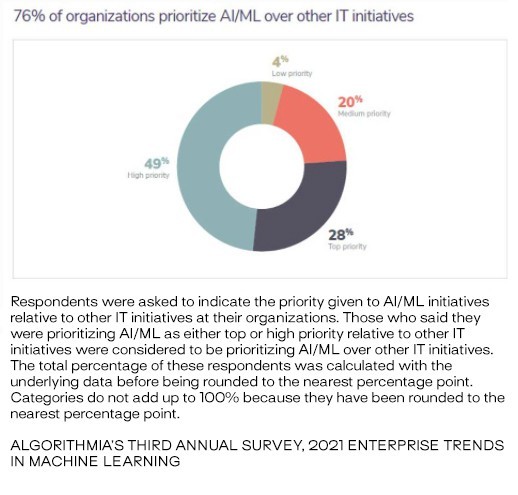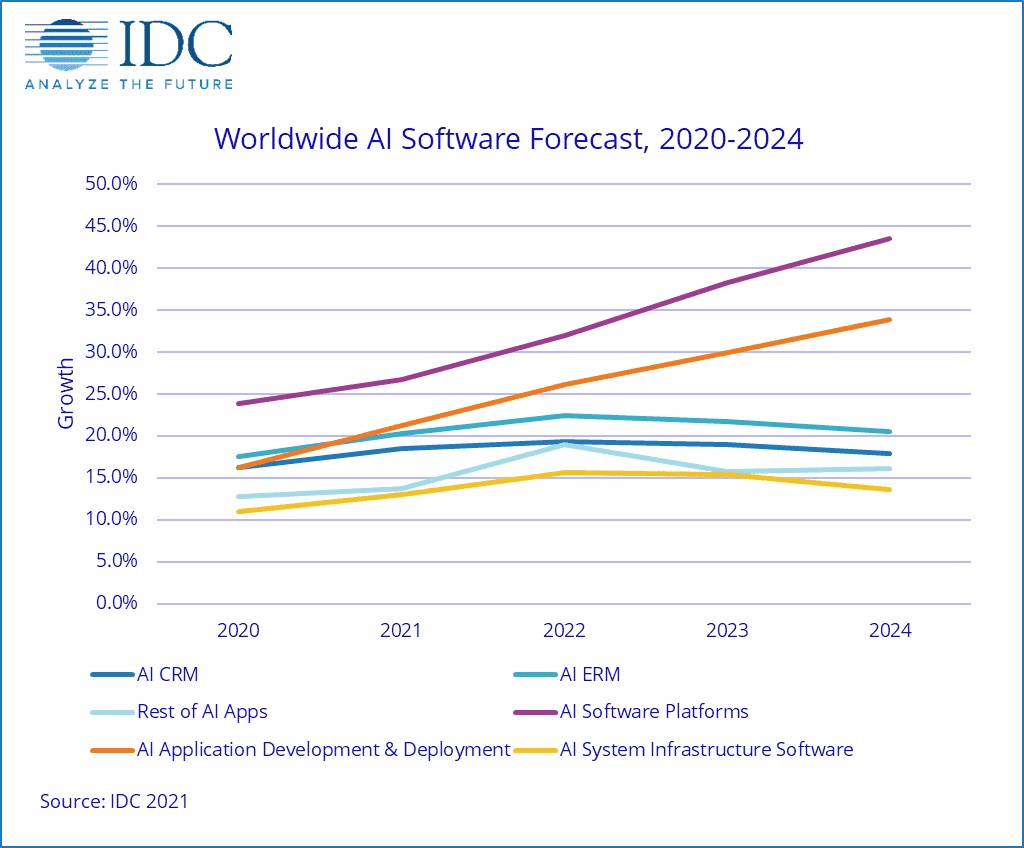19th Aug 2021
The rise of the robots has been a science fiction nightmare for decades, but COVID-19 forced most businesses – and significant number of consumers – to realize that not only do they have nothing to fear, but that machine learning (ML) and other forms of artificial intelligence (AI) bring enormous value to our businesses and our personal lives.
Overcoming this innate anxiety could herald an ongoing period of growth for companies involved in ML (and by extension machine learning ETFs), from those that build chips and infrastructure to those providing tools for building models and others developing new ML applications.
Machine learning is a form of AI that absorbs millions of data points to understand patterns and trends in the data, and then uses that knowledge to create algorithmic models that forecast future events. It has numerous use cases, a number of which came to the fore during COVID-19.
Some industries and verticals may have struggled to survive without ML. According to a recent survey by Algorithmia, 43% of enterprises say that AI and ML initiatives matter more than they had realized, and 25% say they should have prioritized them earlier. 77% say that these now take priority over all other IT innovations, and 83% increased their year-on-year budgets for AI and ML between 2019 and 2020, with 20% raising the budget by more than 50%1

Additionally, while consumers around the world experienced shortages in various key products for varying lengths of time, it would have been much worse if retailers and suppliers hadn’t had the help of ML platforms.
ML helped manufacturing to survive covid lockdowns
The need to keep manufacturing plants functional with most employees working remotely pushed adoption of ML-powered predictive analytics applications. Predictive monitoring and predictive maintenance ensured that part failures and bottlenecks were spotted early even without expert staff onsite, and enabled maintenance teams to schedule repairs for the most convenient times. With the help of digital twins and augmented reality glasses powered by ML, engineers could often diagnose, repair, and reconfigure equipment from a distance.
In response to this spike in demand, Microsoft teamed up with oil and gas applications company Baker Hughes, oil company Shell, and the AI startup C3.ai to create the Open AI Energy Initiative that provides a framework for energy companies to build and access interoperable AI-based solutions.2
ML applications, together with industrial Internet of Things (IIoT) sensors, are now widely used for machine-to-machine (M2M) interactions and robotic process automation (RPA), forming the basis of smart factories. Businesses which are most advanced in their ML adoption are now fielding self-healing machinery which can diagnose and repair its own faults.
ML guided ecommerce through fluctuations in demand
In the early days of the pandemic, when lockdowns were the rule of the day and panic-buying was widespread, demand for staples such as flour, pasta, and toilet paper shot up, as did orders for medical items like masks, alcohol gel, and disposable gloves. Consumers turned to online retailers and wholesalers, who faced a sudden surge in demand at the same time as their supply chains were cracking apart.
Machine learning models helped online and offline businesses predict demand, anticipate new customer requirements, and forecast supply chain bottlenecks and points of failure. With ML predictions, retailers could optimize inventory and identify the most reliable supply chain partners to enable them to meet their customers’ needs.
Even once supply chains began to heal and reassemble, retailers still needed ML forecasting to keep one jump ahead of fluctuating market demands which were difficult to predict using manual data analysis. It’s estimated that AI applications in the retail market will rise at a compound annual growth rate (CAGR) of 34.4% from 2020, reaching $19.9 billion by 20273.
ML underpins a personalized experience
Today, almost everything is personalized, customized, and individualized, from product suggestions to medical treatments. Facebook and Google use ML to serve up relevant ads; Netflix uses it for “watch next” recommendations; and even pharmaceutical companies use it to prepare small-batch, tailored medications.4
ML models crunch big customer data to deliver the right message, content, or product to the right person at the right time. Ecommerce companies and marketplaces like Amazon have already gone a long way to embracing ML to deliver customized product recommendations and personalized marketing messaging.5 A year and more with ecommerce as our primary shopping experience has only reinforced customer expectations for individualized experiences.
Banks, insurance companies, and other finance verticals are now adopting ML to offer personalized digital experiences. Business to business (B2B) customers today also want self-serve, personalized purchase journeys, and enterprises can only nurture them successfully if they harness ML to predict their behavior. ML-powered applications like chatbots further enable companies to provide fast, accurate responses to customer questions.
ML supported public health
Epidemiologists use ML to model the virulence and infectiousness of coronavirus, estimate is reproductive rate, and predict fatalities, long-term illness rates, and the response of the health system. Public health authorities relied on ML forecasts to make decisions regarding lockdowns, mask mandates, and school opening regulations, while economists applied models to estimate the harm restrictions could cause for the local and global economy, and make suggestions about the best ways to mitigate that damage.
Many healthcare providers adopted ML tools to maintain and improve patient care during the pandemic. The rise in telehealth and distance consultations required AI-assisted diagnostics that can help medical professionals pick up on symptoms from a remote patient or examine radiology results on screen. ML forms the foundation for many telehealth applications, like quick and accurate clinical documentation. In April 2021, Microsoft acquired Nuance, which makes ML-powered speech recognition software, for $16 billion, to share Nuance’s AI tools with its healthcare clients6. Nuance offers a virtual assistant for electronic health records, and helps convert clinical conversations into medical notes7. Satya Nadella, CEO of Microsoft, said “AI is technology’s most important priority, and healthcare is its most urgent application. Together with @NuanceInc, we will put advanced AI solutions into the hands of professionals to drive better decision-making and create more meaningful connections.8“
ML innovation is advancing in all directions
One of the main issues holding back ML is a lack of trained talent in data science and AI modeling, so initiatives to train more employees are important for the long-term growth of the sector. In recognition of this, Amazon is taking part in projects to prepare more data science workers, such as a Machine Learning summer school in India9, and an online specialized course in Practical Data Science together with Coursera and Deep.ai.
Analysts predict that the battle for AI chips that power ML applications will heat up10. In March, Applied Materials announced a new optical inspection system called ExtractAI, which uses AI software to spot defects and flaws in AI chips11. One of the leading chip companies, Nvidia, announced a deal to buy UK chip developers Arm Holdings for $40 billion, which was recently endorsed by rivals Broadcom after Nvidia assured the market that it would share new chip-making technology12. Nvidia shares have risen approximately 30% in the last quarter, and its revenues grew 84% year on year in 2020 to $5.7 billion13.
Meanwhile, cloud services giants Google (owned by Alphabet), Amazon Web Services, and Microsoft are competing to sell ML-powered predictive analytics solutions to cloud customers, to capitalize on the demand for advanced analytics. Google itself recently partnered with Nvidia to create the first AI-on-5G innovation lab, which will support AI software developers and infrastructure vendors to develop, test, and adopt innovations for smart factories, smart cities, and other advanced ML-powered applications on 5G. Ronnie Vasishta, senior vice president of Telecom at NVIDIA, said “Our collaboration with Google Cloud will help network operators and infrastructure players conceive and create new profit centers built on AI and machine learning.14” Alphabet’s stock price rose 34% so far in 202115.
Accenture stock is also benefiting from the ML wave. The company helps enterprises adopt ML solutions as part of digital transformations, and has seen demand for its services rise. Accenture increased its revenue by 8% year on year in Q1 2021, to $12.1 billion, and expects Q2 revenue to grow by 10%-13%16.
Free of fear, the ML market is rapidly expanding
The IDC predicts that global revenues for the AI market will grow 16.4% year on year to $327.5 billion by 2021, and reach $554.3 billion total revenues at a CAGR of 17.5% by 2024, with AI applications leading growth at 32.7% CAGR over 5 years.

“The global pandemic has pushed AI to the top of the corporate agenda, empowering business resilience and relevance,” says Ritu Jyoti, program vice president for AI Research at IDC. “AI is becoming ubiquitous across all the functional areas of a business.”17
With businesses, manufacturing, and consumers alike recognizing the value that machine learning can bring, ML stocks and the broader AI market in general could be on the brink of unprecedented growth.
1 “76% Of Enterprises Prioritize AI & Machine Learning In 2021 IT Budgets” January 17, 2021 https://www.forbes.com/sites/louiscolumbus/2021/01/17/76-of-enterprises-prioritize-ai–machine-learning-in-2021-it-budgets/?sh=70eff701618a
2 “Shell, C3 AI, Baker Hughes, and Microsoft Launch the Open AI Energy Initiative, an Ecosystem of AI Solutions to Help Transform the Energy Industry” February 1, 2021 https://c3.ai/shell-c3-ai-baker-hughes-and-microsoft-launch-the-open-ai-energy-initiative-an-ecosystem-of-ai-solutions-to-help-transform-the-energy-industry/
3 “Artificial Intelligence in Retail Market Worth $19.9 Billion by 2027, Growing at a CAGR of 34.4% From 2020 – Exclusive Report by Meticulous Research®” May 25, 2021 https://www.globenewswire.com/en/news-release/2021/05/25/2235318/0/en/Artificial-Intelligence-in-Retail-Market-Worth-19-9-Billion-by-2027-Growing-at-a-CAGR-of-34-4-From-2020-Exclusive-Report-by-Meticulous-Research.html
4 Note that Facebook and Netflix are not among QTUM’s holdings. Google is a QTUM holding, constituting about 1.49% of the ETF’s NET assets (as of July 22, 2021).
5 Note that Amazon is not in QTUM’s holdings (as of July 22, 2021).
6 “Microsoft accelerates industry cloud strategy for healthcare with the acquisition of Nuance” April 12, 2021 https://news.microsoft.com/2021/04/12/microsoft-accelerates-industry-cloud-strategy-for-healthcare-with-the-acquisition-of-nuance/. Microsoft constitutes about 1.56% of QTUM’s net assets (as of July 22, 2021).
7 “Why Microsoft’s new AI acquisition is a big deal” April 17, 2021 https://venturebeat.com/2021/04/17/why-microsofts-new-ai-acquisition-is-a-big-deal/
8 Twitter, April 12, 2021 https://twitter.com/satyanadella/status/1381587051431174144
9“Amazon India Launches Machine Learning Summer School” June 14, 2021 https://analyticsindiamag.com/amazon-india-launches-machine-learning-summer-school/
10 “Battle In AI Chips Heats Up As Nvidia Faces A Brigade Of Rivals” December 30, 2019 https://www.investors.com/news/technology/ai-chips-nvidia-artificial-intelligence-stocks/
11 “AI Meets Chipmaking” March 19, 2021 https://www.anandtech.com/show/16565/applied-materials-wafer-inspection-tools-use-ai-and-big-data-to-cut-inspection-costs-by-3x
12 “Why NVIDIA Stock Was Up Today” June 28, 2021 https://www.fool.com/investing/2021/06/28/why-nvidia-stock-was-up-today/
13 “5 Machine Learning Stocks to Capture Massive Growth” June 4, 2021 https://www.nasdaq.com/articles/5-machine-learning-stocks-to-capture-massive-growth-2021-06-04
14 “NVIDIA and Google Cloud to Create Industry’s First AI-on-5G Lab to Speed Development of AI Everywhere” June 28, 2021 https://nvidianews.nvidia.com/news/nvidia-and-google-cloud-to-create-industrys-first-ai-on-5g-lab-to-speed-development-of-ai-everywhere
15 Nvidia shares constitute approximately 1.58% of QTUM’s net assets (as of July 22, 2021). “5 Machine Learning Stocks to Capture Massive Growth” June 4, 2021 https://www.nasdaq.com/articles/5-machine-learning-stocks-to-capture-massive-growth-2021-06-04
16 “5 Machine Learning Stocks to Capture Massive Growth” June 4, 2021 https://www.nasdaq.com/articles/5-machine-learning-stocks-to-capture-massive-growth-2021-06-04
17 “IDC Forecasts Improved Growth for Global AI Market in 2021” February 23, 2021 https://www.idc.com/getdoc.jsp?containerId=prUS47482321